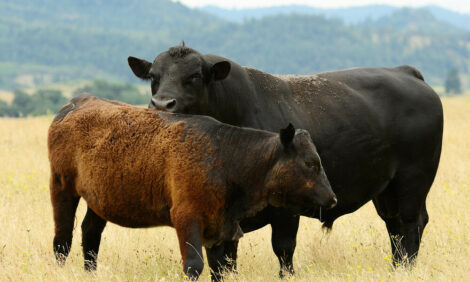



Cattle Prices To Stay Strong but Keep an Eye On Corn
US - A Texas AgriLife Extension Service livestock economist has forecasted continued strength in cattle prices heading into 2011, but has warned to keep a watchful eye on the corn supply.Dr. David Anderson said at the recent Brock Faulkner Cattleman's Clinic/Doug Davidson Hay Show in Bryan that cattle numbers will be fewer over the next decade, but the price of corn will dictate the level and spread in calf prices.
"I think we will continue seeing beef production and cattle numbers drop off in the next couple of years," Anderson said.
"We are forecast to produce 25.4 billion pounds of beef in 2011 versus 25.9 billion pounds in 2010. That will lead to increases in price, but it also depends on corn prices and (their effect on) calf prices."
With the nation's corn supply receiving more attention in recent weeks as a result of declining harvest yield estimates, Anderson said he has backed off somewhat on his price outlook for the calf market heading into 2011.
Anderson said producers can expect to see higher calf prices next year, but not as high as he first estimated earlier this year. His 2011 forecast has 600-pound calves priced at $104 to $112 per hundredweight and 700-800-pound calves priced at $99-$105 per hundredweight.
The first quarter of 2010 resulted in the least amount of beef supplies, net of beef exports, since 1997, and each quarter through 2012 will continue to decline, Anderson said. Overall, beef demand has been hurt by the recession, but has been strong due to consumers "trading down" to stretch their income. That's led to more grinding of specific cuts of beef – chucks and rounds – to "take advantage of the hamburger demand."
Cull cattle have also been fetching premium prices – a result of the demand for ground beef.
The export markets also continue to show strength with Vietnam emerging as a top customer for U.S. beef exports.
"What I'm suggesting is that booming exports tighten domestic beef supplies even more and should lead to higher cattle prices for the next couple of years," Anderson said.
"Supplies keep cutting back because we're not making enough money to build herds back."
The last few years have been one of transition for the cattle industry, Anderson said, as beef cattle numbers are at the lowest since the 1950s. However, pounds of beef produced per cow are much higher compared to that period as a result of feeding, improved breeding, and overall technology and science.
"We're not using the same type of cattle we were using in the 1950s," Anderson said.
With higher corn prices, one of the important things to do in the current calf market, is to put purchased calves on grass to cut down on the amount of costs to add pounds, Anderson said.
"Putting them on grass becomes cheaper when you look at the cost of corn," he said.
"The price spread, or slide, becomes compressed as corn prices move higher. The hardest hit are often the lightweight heifers since it takes more feed to put gain on them."
Overall, there are fewer replacement heifers being held back, Anderson said.
"We're also slaughtering more cows as a percent of the herd than in a decade," he said.
"We're going to have fewer cows in 2011-2012, but also higher prices."



